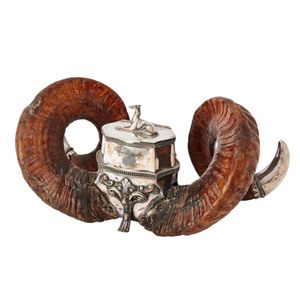Victorian Ram's Horn Snuff Mull with Greyhound Mount
A Scottish Victorian ram's Horn snuff mull, the hinged cover surmounted by a recumbent greyhound on a scrolled mount and footed supports issuing the two metal mounted horns, the silverplate mounts with maker's mark of George Cutts & Sons, Sheffield (active 1857-1896). Provenance: Rippon Lea Estate, Elsternwick, Victoria. Hamish Clark Antiques, 1998. Contents of Swanton, Sutton Forest. Other Notes: Rippon Lea Estate was built in 1868 for Sir Frederick Surgood, a wealthy Melbourne businessman, politician and philanthropist.
You must be a subscriber, and be logged in to view price and dealer details.
Subscribe Now to view actual auction price for this item
When you subscribe, you have the option of setting the currency in which to display prices to $Au, $US, $NZ or Stg.
This item has been sold, and the description, image and price are for reference purposes only.
- Horn - Full horns were used for making drinking vessels and powder horns. A number of larger horns or antlers could be combined together to make furniture and decorative items such as chairs and lamps.
As a material, horn was formerly used in all types of objects such as snuff boxes, lanterns, musical instruments, items for personal grooming, cutlery handles, walking sticks. Some items of horn are finely decorated with silver or mounted in silver. - Victorian Period - The Victorian period of furniture and decorative arts design covers the reign of Queen Victoria from 1837 to 1901. There was not one dominant style of furniture in the Victorian period. Designers used and modified many historical styles such as Gothic, Tudor, Elizabethan, English Rococo, Neoclassical and others, although use of some styles, such as English Rococo and Gothic tended to dominate the furniture manufacture of the period.
The Victorian period was preceded by the Regency and William IV periods, and followed by the Edwardian period, named for Edward VII (1841 ? 1910) who was King of the United Kingdom and the British Dominions and Emperor of India for the brief period from 1901 until his death in 1910.
This item has been included into following indexes:
